
Upgrading Lab Doors: When to Replace vs. When to Retrofit?
- By:Lisa
- 2025-11-11
- 29
In the fields of research, pharmaceuticals, biosafety, and clean manufacturing, laboratory doors are no longer simple access points, but core functional components that ensure environmental safety, maintain airflow control, and guarantee compliance. However, due to the stereotype of being “non-critical equipment,” many laboratories only respond reactively after door aging, seal failure, or pressure loss occurs—leading to failed inspections, non-compliance audits, and even safety incidents.
Faced with performance degradation or updated standards, facility managers face a key question: Should the laboratory door be replaced entirely, or should it be upgraded through localized retrofit? This decision affects not only short-term budgets, but also operational efficiency and compliance levels over the next 5–10 years.
I. The Core Functions of Laboratory Doors Extend Far Beyond Ordinary Doors

1.1 Airtightness and Pressure Differential: The First Line of Defense for Environmental Stability
Cleanrooms and biosafety laboratories impose extremely strict controls on airflow. According to the ISO 14644-1:2015 standard, an ISO Class 5 (formerly Class 100) cleanroom requires that the number of particles ≥0.5μm per cubic meter must not exceed 3,520; while GB 50073-2013 Design Code for Clean Rooms clearly stipulates that the pressure differential between Class A cleanrooms and adjacent lower-grade areas should be maintained at +10 to +15 Pa.
In negative-pressure laboratories (such as BSL-2 or BSL-3 biosafety labs), the pressure gradient must be controlled in reverse, with the core area typically maintained at –10 to –30 Pa to prevent the escape of hazardous aerosols. At this point, even minor gaps in the door can directly disrupt airflow organization and lead to contamination.
The ASHRAE Standard 110 Laboratory Ventilation Performance Test Standard indicates that a qualified door must achieve a leakage rate of ≤0.02 L/s·m² at a 15 Pa pressure differential. In contrast, ordinary doors, due to seal aging or installation deviation, commonly exhibit leakage rates as high as 0.1–0.3 L/s·m²—far exceeding the safety threshold.
The sealing performance of the laboratory door directly affects whether the environmental classification is met. If pressure alarms occur frequently, the primary component to inspect is often the door itself.
1.2 Fire Resistance and Fire Integrity: The Last Line of Safety
According to NFPA 45 Fire Protection Standard for Laboratories and UL 10B fire resistance testing standards, laboratory doors must have a fire resistance rating of at least 45 minutes to 2 hours. This requires not only that the door panel material be flame-retardant, but also that all components—including the frame, hinges, door closer, and seals—collectively pass the overall fire resistance certification.
When a fire occurs, if the door cannot effectively block flames and high-temperature smoke, it will allow the fire to spread along corridors, endangering evacuation routes. A 2021 report by the National Academy of Sciences of the United States indicated that over 22% of laboratory fire-related injuries were linked to non-compliant door fire performance.
A fire rated door for laboratory is not merely a selection requirement—it is a compliance baseline. Many laboratories have been ordered to rectify their operations during fire inspections due to the use of non-certified doors, disrupting research progress.
1.3 Chemical Resistance and Surface Cleanability: Key to Preventing Contamination Accumulation
Laboratory doors are frequently exposed to strong acids, strong bases, organic solvents, and high-concentration disinfectants (e.g., 75% ethanol, peracetic acid, sodium hypochlorite). If the surface material is ordinary spray-painted steel plate or wood veneer, it is prone to corrosion, blistering, and peeling, forming “dead zones” where microorganisms can hide.
GB 19489-2008 General Requirements for Laboratory Biosafety explicitly requires that the surfaces of biosafety laboratory enclosures be “smooth, crack-free, easy to clean, and corrosion-resistant.” Door materials must meet the ASTM D1308 chemical resistance test standard, with surface roughness (Ra) controlled at ≤0.8 μm to facilitate frequent wiping and disinfection.
The selection of chemical resistant door materials directly affects cleaning efficiency and the risk of cross-contamination.
1.4 Intelligent Integration and Access Control: The Digital Nerve Endings of Modern Laboratories
New-generation laboratories commonly integrate access control systems, pressure monitoring, fire linkage, and electronic logging functions. Doors must support:
- Electromagnetic locks or electronic locks linked to permission systems;
- Door status sensors that upload real-time signals of “open/closed/abnormal”;
- Emergency release mechanisms to ensure manual opening during power failure;
- Communication interfaces with Building Automation Systems (BAS) or Laboratory Information Management Systems (LIMS).
If the door lacks reserved wiring channels or control module mounting positions, later installation will compromise structural integrity and result in unstable signals, affecting system reliability.
Smart access control for lab facilities has become a standard feature in high-end laboratories, not an optional one.
II. Five Clear Signs That Require Full Replacement
When a laboratory door exhibits any of the following conditions, lab door replacement is the only safe, compliant, and economical solution.
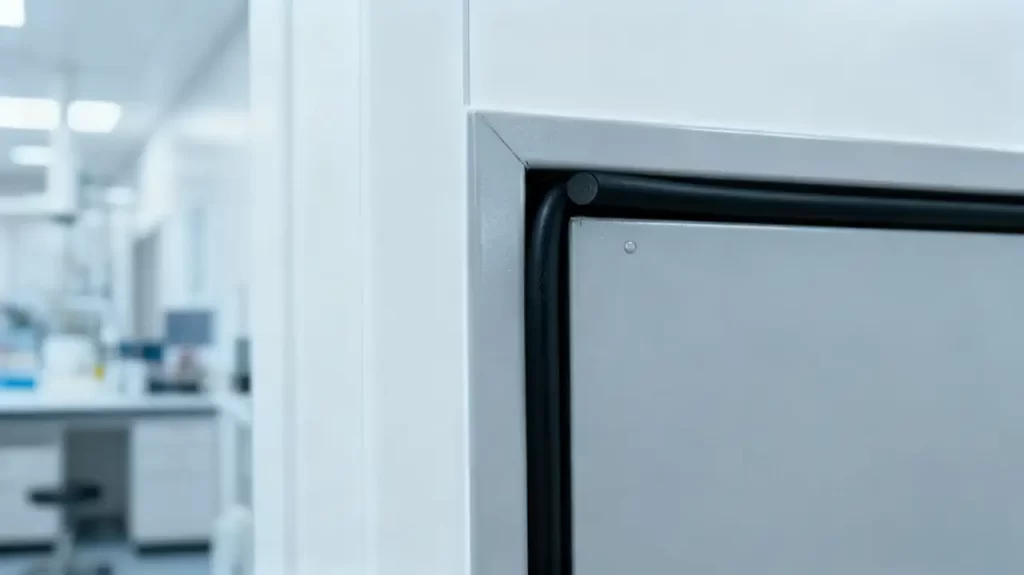
2.1 Structural Deformation, Irreversible Seal Failure
Door sagging, frame warping, or elongated hinge holes will prevent the door from closing completely. Even replacing the seal cannot restore airtightness. Laser level measurements show that when the frame vertical deviation exceeds 3 mm/m, or the gap between the door and frame is unevenly greater than 5 mm, irreversible structural deformation has occurred.
A real-case measurement: In a P2 laboratory at a top-tier hospital, prolonged moisture exposure caused door deformation, resulting in a maximum gap of 8 mm upon closing and a pressure fluctuation of ±12 Pa, leading to three consecutive environmental monitoring failures. After replacement, the leakage rate dropped from 0.21 L/s·m² to 0.016 L/s·m², passing certification on the first attempt.
2.2 Severe Corrosion or Aging, Irreparable
In high-humidity or high-chemical-exposure environments, ordinary carbon steel door frames are prone to rusting; 304 stainless steel may suffer pitting corrosion due to chloride ions; and aluminum alloy doors without surface treatment may exhibit whitening or powdering.
According to a 2023 survey by the journal Clean and Air Conditioning Technology, over 40% of laboratory door replacements were driven by material corrosion. Corrosion not only weakens structural strength, but also accumulates dirt in gaps, forming biofilms and becoming a persistent contamination source.
2.3 Non-Compliance with Current Safety Regulations
Regulations continue to evolve, and older doors often become compliance blind spots. For example:
- NFPA 45 (2022 Edition) requires: Laboratory doors must be equipped with automatic door closers, with closing times controlled within 5–10 seconds; manual closers are prohibited;
- EN 1634-1 (EU) clearly stipulates: The entire door assembly must pass a full fire resistance test; certification of the door panel alone is invalid;
- GMP Annex 1 (2023) emphasizes: Doors in sterile operation areas must have double-door interlock functionality to prevent simultaneous opening.
If the original door lacks an automatic closer, interlock design, or meets a fire rating below current standards, retrofitting cannot satisfy regulatory requirements—replacement is mandatory.
2.4 Severely Outdated Functionality, Incompatible with Modern Systems
Many laboratories still use mechanical locks, magnetic door closers, or ordinary doors without sensors. When integrating with intelligent management systems, two major challenges arise:
- No power interfaces or signal conduits; forced wiring damages structure;
- No reserved mounting positions; sensors cannot be fixed, leading to data drift.
A biopharmaceutical company attempted to install a pressure sensor on an old door to upgrade its LIMS system. Due to the door’s thin material and lack of structural support, the sensor repeatedly detached. After six weeks and an investment exceeding 30% of the price of a new door, the system still failed to operate stably, ultimately requiring full replacement.
2.5 Maintenance Costs Exceed Economic Thresholds
Facility management must consider Total Cost of Ownership (TCO). When annual maintenance costs (including labor, parts, and downtime losses) exceed 15% of the price of a new door, or cumulative repair costs exceed 60% of the new door price, replacement becomes the optimal choice.
Typical data:
| ITEM | OLD DOOR ANNUAL COST | NEW DOOR ANNUAL COST | PAYBACK PERIOD |
|---|---|---|---|
| Repair Costs | ¥12,000 | ¥1,200 | 1.8 years |
| Downtime Losses | ¥8,000 | ¥0 | — |
| Energy Increase | ¥3,500 | ¥0 | — |
| Total | ¥23,500 | ¥1,200 | 1.1 years |
— Data source: China National Accreditation Service for Conformity Assessment (CNAS) 2024 Facility Operations White Paper
III. Typical Scenarios Suitable for Retrofit
If the door structure is intact, free of corrosion and deformation, and only suffers from outdated functions or worn components, laboratory door retrofit is an efficient, economical, and low-disruption preferred option.
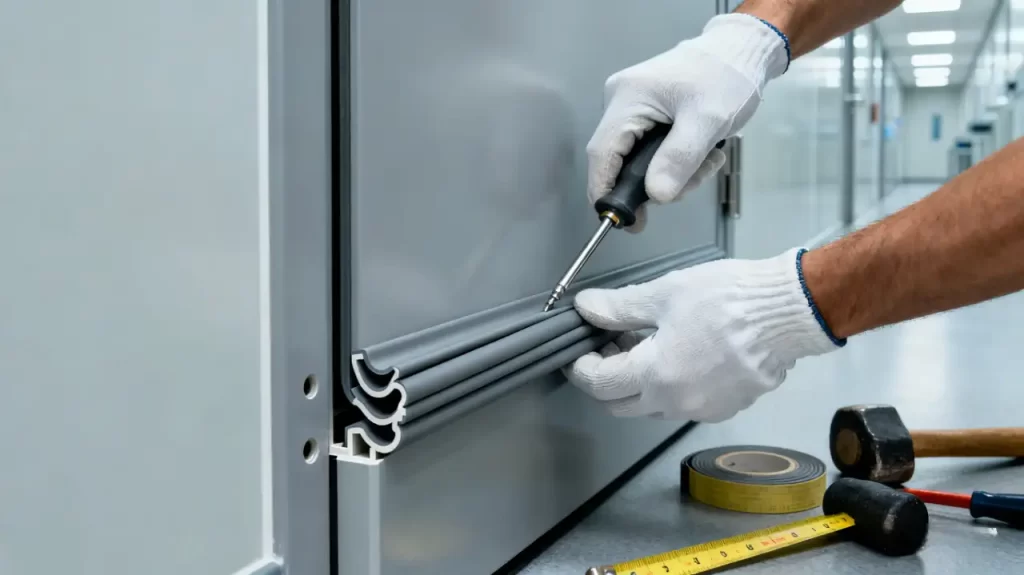
3.1 Precondition for Retrofit: Structural Integrity
Professional inspection must be conducted before retrofitting:
- Use a laser distance meter to measure frame verticality and levelness (deviation ≤1.5 mm/m);
- Use infrared thermography to check for voids or moisture in the door panel core;
- Manually test closure tightness to confirm no visible light leakage or air draft.
Only if all conditions are met may retrofitting proceed.
3.2 Key Retrofit Modules and Implementation Pathways
3.2.1 Comprehensive Seal System Upgrade
The original EPDM seal typically lasts 3–5 years. After prolonged use, its resilience declines, and its compression set exceeds 30% (ASTM D395), indicating failure.
Recommended replacement options:
- FFKM (Perfluoroelastomer): Temperature range –60°C to +200°C, highly resistant to chemical corrosion, suitable for strong acid/alkali environments, service life exceeds 10 years;
- Silicone-glass fiber composite seal: High flexibility, suitable for uneven door gaps, compression recovery rate >85%;
- Lip-type + dual-seal structure: Enhances sealing redundancy; if one seal fails, the second still maintains basic airtightness.
After retrofit, leakage rates can be reduced by 60–75%, significantly improving pressure stability.
3.2.2 Precise Hardware Replacement
- Door closer: Replace with a hydraulic door closer compliant with ANSI/BHMA A156.1 Grade 1 standard, ensuring smooth, impact-free closure with controllable closing time (6–8 seconds);
- Hinges: Use stainless steel 3-axis adjustable hinges, supporting fine-tuning in vertical, horizontal, and depth directions (±3 mm), compensating for installation errors and improving closure accuracy;
- Lock: Upgrade to electromagnetic locks or electronic latch locks, supporting remote authorization, card/fingerprint access, and integration with access control systems.
3.2.3 Intelligent System Integration
No need to replace the entire door to achieve intelligence:
- Embed a miniature wireless pressure sensor (range ±50 Pa, accuracy ±0.5 Pa) inside the door frame; data is uploaded to a central platform via wireless modules (LoRa/Bluetooth);
- Install door status monitoring switches to provide real-time feedback of “normally closed,” “abnormally opened,” or “left open for extended periods”;
- Integrate emergency buttons that release locks with one touch during fire or chemical release events, ensuring unobstructed evacuation routes.
Such retrofitting costs approximately ¥2,000–5,000 per door, but significantly improves management efficiency and compliance levels.
3.2.4 Surface Refurbishment and Antimicrobial Treatment
For doors with peeling coatings or scratches, perform:
- Surface grinding, rust removal, and cleaning;
- Spray-coating with food-grade epoxy resin coating (complying with FDA 21 CFR 175.300);
- Or apply antimicrobial coatings (e.g., silver-ion based), reducing microbial adhesion.
This approach is suitable for non-cleanroom or auxiliary laboratories, offering low cost and short cycle time.
IV. Decision Framework: Four-Dimensional Evaluation Model for Replacement vs. Retrofit
To avoid subjective judgment, a structured decision model is recommended, evaluating across four dimensions:
| DIMENSION | REPLACEMENT ADVANTAGE | RETROFIT ADVANTAGE |
|---|---|---|
| Safety | Fully new design, 100% compliant with latest standards | Relies on original structure; risk is higher if base is poor |
| Compliance | One-time compliance, avoids audit risks | Requires individual verification; some regulations do not support retrofit |
| Cost | High initial investment (¥5,000–¥20,000 per door) | Low cost (typically 30–50% of replacement) |
| Downtime | Requires demolition and reconstruction, typically 3–7 days | Localized construction, typically <48 hours |
Decision Flowchart
- Assess structural integrity → Is the frame deformed, door panel cracked, or severely corroded? → Yes → lab door replacement → No → Proceed to next step
- Verify regulatory compliance → Does it lack automatic closer, double-door interlock, or fire rating? → Yes and cannot be retrofitted to meet requirements → lab door replacement → No or can be retrofitted to meet requirements → Proceed to next step
- Evaluate functional needs → Is integration of intelligent monitoring or remote control required? → Yes and original door has no reserved interfaces → lab door replacement → No or can be added → laboratory door retrofit
- Calculate Total Cost of Ownership (TCO) → Will maintenance + energy + downtime costs over 5 years exceed 60% of the new door price? → Yes → lab door replacement → No → laboratory door retrofit
✅ Recommended strategy: Intact structure + outdated function → Prioritize retrofit; Damaged structure + non-compliant with regulations → Mandatory replacement.
V. Real-World Case Study: Modernization of a BSL-3 Laboratory Door
5.1 Project Background
A provincial CDC BSL-3 laboratory had doors in service for 9 years, frequently triggering pressure alarms (averaging 3–5 per week), with noisy door closers and no ability to connect to the newly launched intelligent monitoring platform. The laboratory needed to complete the upgrade within three months without disrupting routine testing.
5.2 Diagnosis and Solution Selection
- Inspection results: Frame showed no deformation; door panel showed no corrosion; seal was severely aged (compression set at 42%);
- Door closer was mechanical spring-type, lacking damping, causing significant impact on closure;
- No sensor interface, unable to upload status data.
Conclusion: Structure intact, functionality outdated—suitable for laboratory door retrofit.
5.3 Implementation Plan
- Replaced with FFKM triple-seal system;
- Installed hydraulic door closer (compliant with ANSI Grade 1);
- Embedded wireless pressure sensors and door status switches at the top of the door frame;
- Surface cleaned and coated with antimicrobial finish;
- All components provided by a supplier with laboratory engineering experience, with no brand preference.
5.4 Performance Comparison
| METRIC | BEFORE RETROFIT | AFTER RETROFIT | IMPROVEMENT |
|---|---|---|---|
| Pressure fluctuation | ±12 Pa | ±1.5 Pa | ↓ 87.5% |
| Monthly alarm frequency | 18 times | 1 time | ↓ 94% |
| Door closing noise | 78 dB | 46 dB | ↓ 41% |
| System integration | Not connected | Real-time upload | 100% |
| Downtime | 4 days (original plan) | 22 hours | ↓ 94% |
| Total investment | — | ¥18,600 | — |
Payback period: 1.3 years (based on annual savings from retesting, energy waste, and manual inspection costs).
VI. Procurement and Implementation Recommendations: Ensuring Successful Upgrades
6.1 Supplier Capability Review Checklist
| REVIEW ITEM | REQUIREMENT |
|---|---|
| Industry Experience | At least 3+ laboratory/cleanroom project cases |
| Material Certification | Provide ASTM D395 for seals, UL 94 flame retardant certification, ANSI/BHMA A156.1 Grade 1 certification for closers |
| Delivery Capability | Can provide on-site measurement and custom installation services |
| Technical Documentation | Provide installation manuals, maintenance guides, performance test reports |
| After-sales Support | Provide 1+ year warranty, response time ≤4 hours |
6.2 Required Technical Documentation
- Material composition and chemical resistance test report for the door;
- Compression recovery rate data for seals (ASTM D395);
- Door closing time curve chart for the closer;
- Sensor accuracy and communication protocol specifications;
- Post-installation airtightness test report (recommended: smoke test or pressure decay method).
6.3 Installation and Acceptance Criteria
- After closing, gaps must be uniform, maximum gap ≤2 mm;
- Door closer operates smoothly, no rebound, no impact;
- Intelligent system data upload accuracy ≥99%;
- Pass pressure differential test (leakage rate ≤0.02 L/s·m² at 15 Pa);
- All labels are clear; emergency release device is manually operable.
VII. Conclusion: From Reactive Maintenance to Proactive Facility Management
Upgrading laboratory doors should not be a reactive “firefighting” response to failures, but rather integrated into a strategic Facility Lifecycle Management (FLM) framework.
It is recommended to establish the following mechanisms:
- Annual inspection system: Conduct airtightness testing of doors every six months, recording pressure trend changes;
- Performance early-warning threshold: Trigger evaluation if leakage rate increases by more than 15% over three consecutive months;
- Updated alternative list: Pre-stock door models compliant with the latest standards to shorten response time;
- Budget reserve mechanism: Reserve 3–5% of total laboratory count annually for door upgrades.
In today’s era of increasingly precise scientific research and continuously tightening safety standards, the value of a door extends far beyond its physical form—it is a reflection of the reliability of the laboratory system, and an embodiment of scientific rigor.
Choosing between lab door replacement and laboratory door retrofit is not a technical decision. It is a responsibility.
-
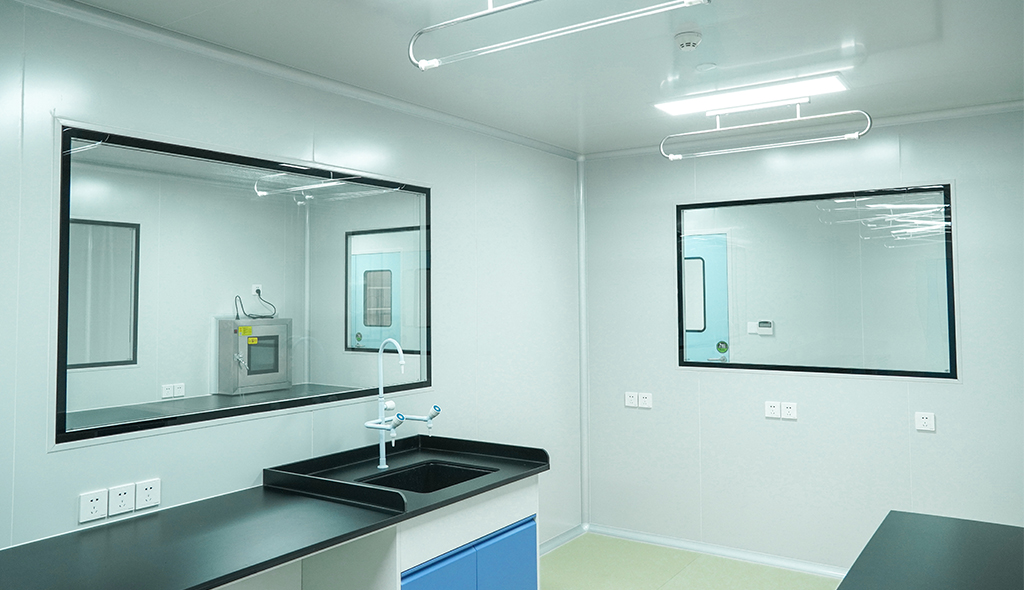 Cleanroom Glass Windows Are The Key to Maintaining a Clean Environment
Cleanroom Glass Windows Are The Key to Maintaining a Clean Environment -
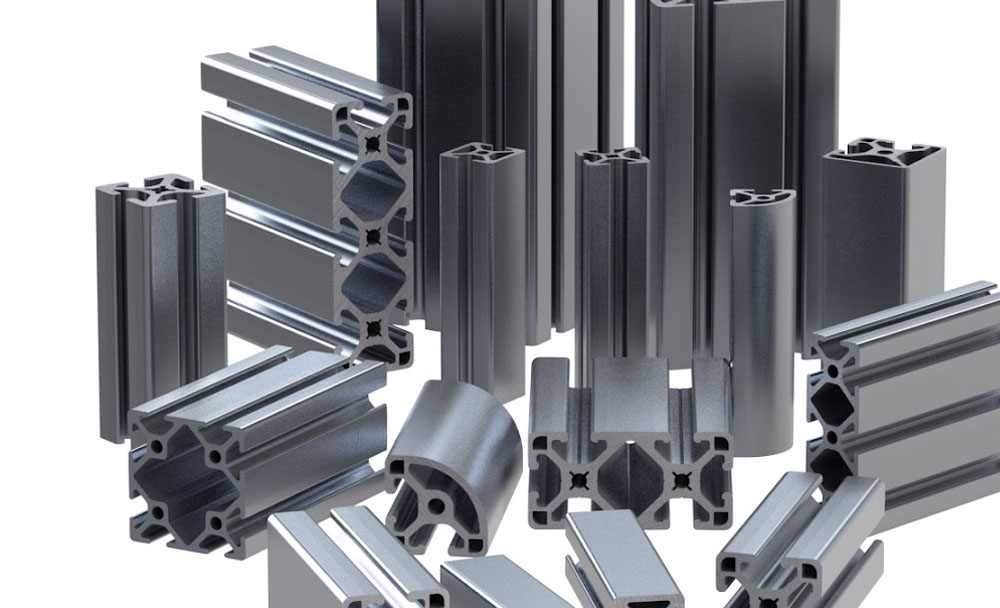 Top Aluminium Profile Manufacturers in China: Leading the Global Market
Top Aluminium Profile Manufacturers in China: Leading the Global Market -
 The Evolution of Air Tight Sliding Doors
The Evolution of Air Tight Sliding Doors -
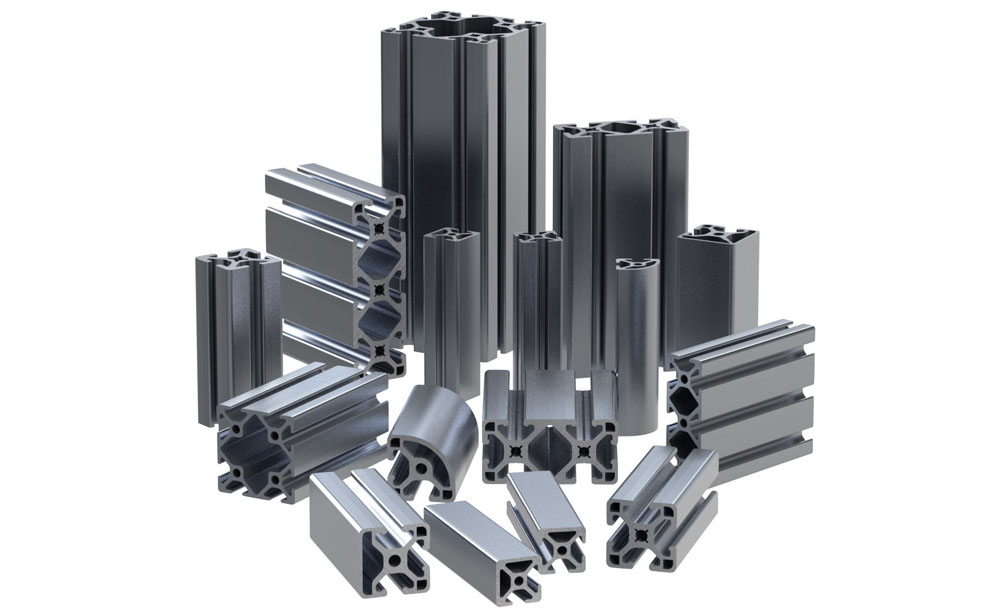 AHU Aluminium Profile: A Comprehensive Guide
AHU Aluminium Profile: A Comprehensive Guide -
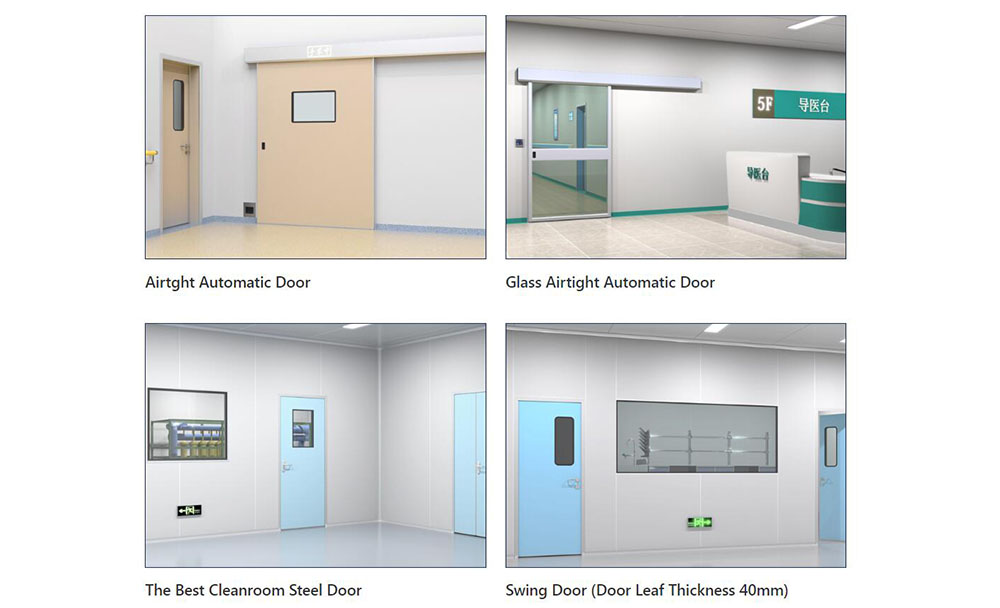 The Importance of Choosing the Right Cleanroom Door in Vietnam
The Importance of Choosing the Right Cleanroom Door in Vietnam -
 The Benefits of Hospital Automatic Doors: Enhancing Efficiency and Safety
The Benefits of Hospital Automatic Doors: Enhancing Efficiency and Safety -
.jpg) The Best Bathroom Door Manufacturers - Unlocking Endless Possibilities!
The Best Bathroom Door Manufacturers - Unlocking Endless Possibilities! -
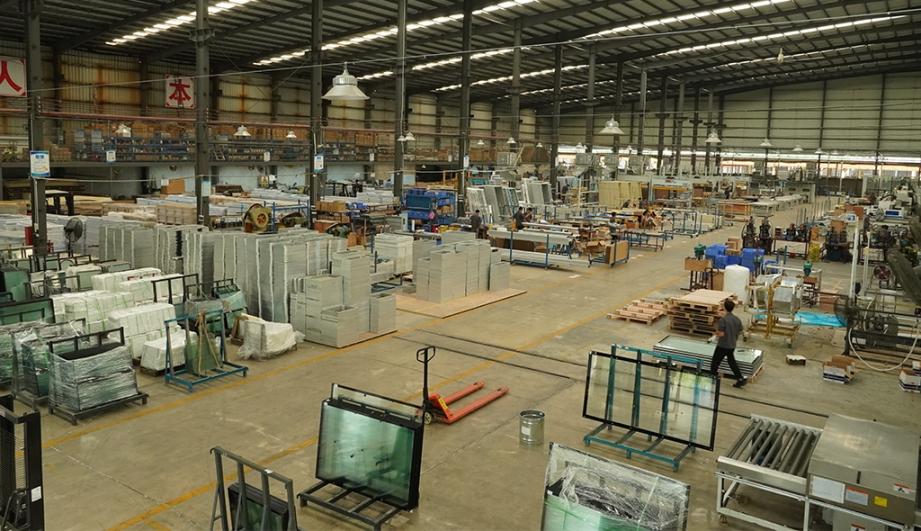 Unlock the Possibilities with AJ Manufacturing Doors
Unlock the Possibilities with AJ Manufacturing Doors -
 Make a Statement with Manufactured Home Interior Doors!
Make a Statement with Manufactured Home Interior Doors! -
 what is aluminum profile? Aluminum Profiles for Your Home is the best option
what is aluminum profile? Aluminum Profiles for Your Home is the best option
-
 How to Extend the Life of Your Exterior Steel Door
How to Extend the Life of Your Exterior Steel Door -
 What Are the Best Materials for AC Vent Covers
What Are the Best Materials for AC Vent Covers -
 Ceiling Vent Covers Labeled Fire-Rated? Here’s How to Verify
Ceiling Vent Covers Labeled Fire-Rated? Here’s How to Verify -
 Upgrading Lab Doors: When to Replace vs. When to Retrofit?
Upgrading Lab Doors: When to Replace vs. When to Retrofit? -
 Stainless Steel Door vs. Alternatives in Cleanrooms
Stainless Steel Door vs. Alternatives in Cleanrooms -
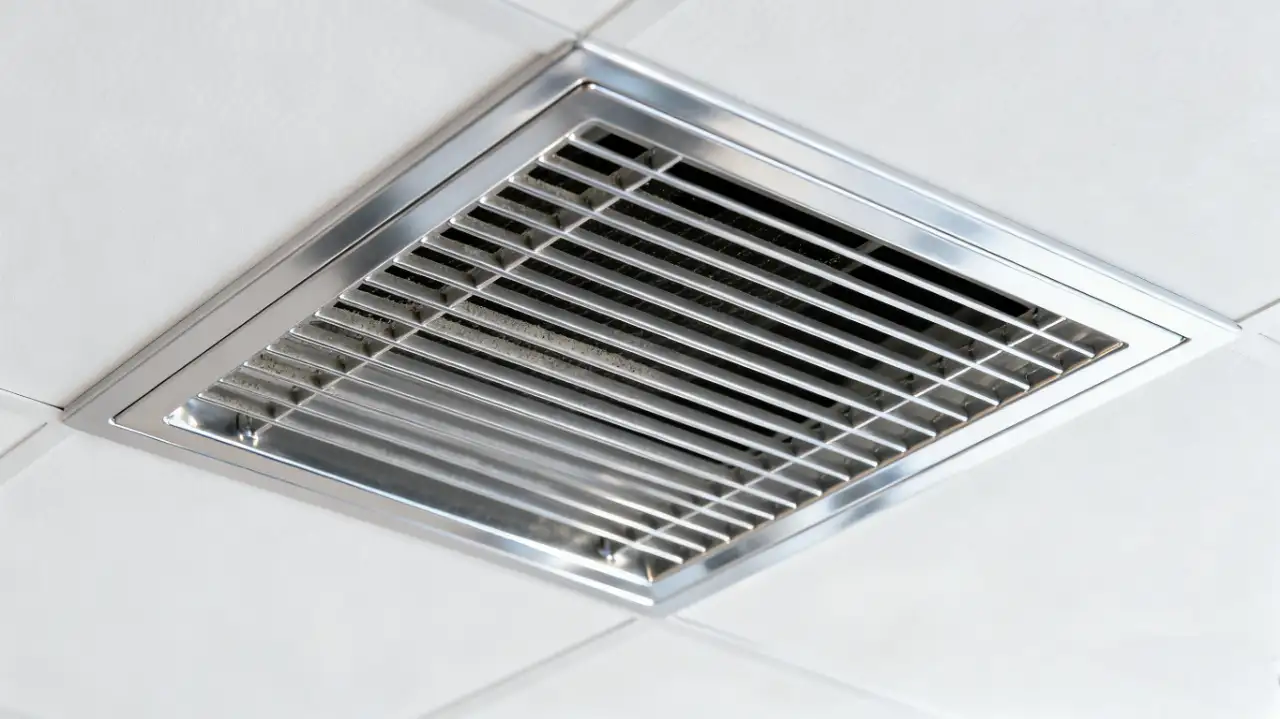 Ceiling Vent Care Tips to Boost HVAC Efficiency Year Round
Ceiling Vent Care Tips to Boost HVAC Efficiency Year Round -
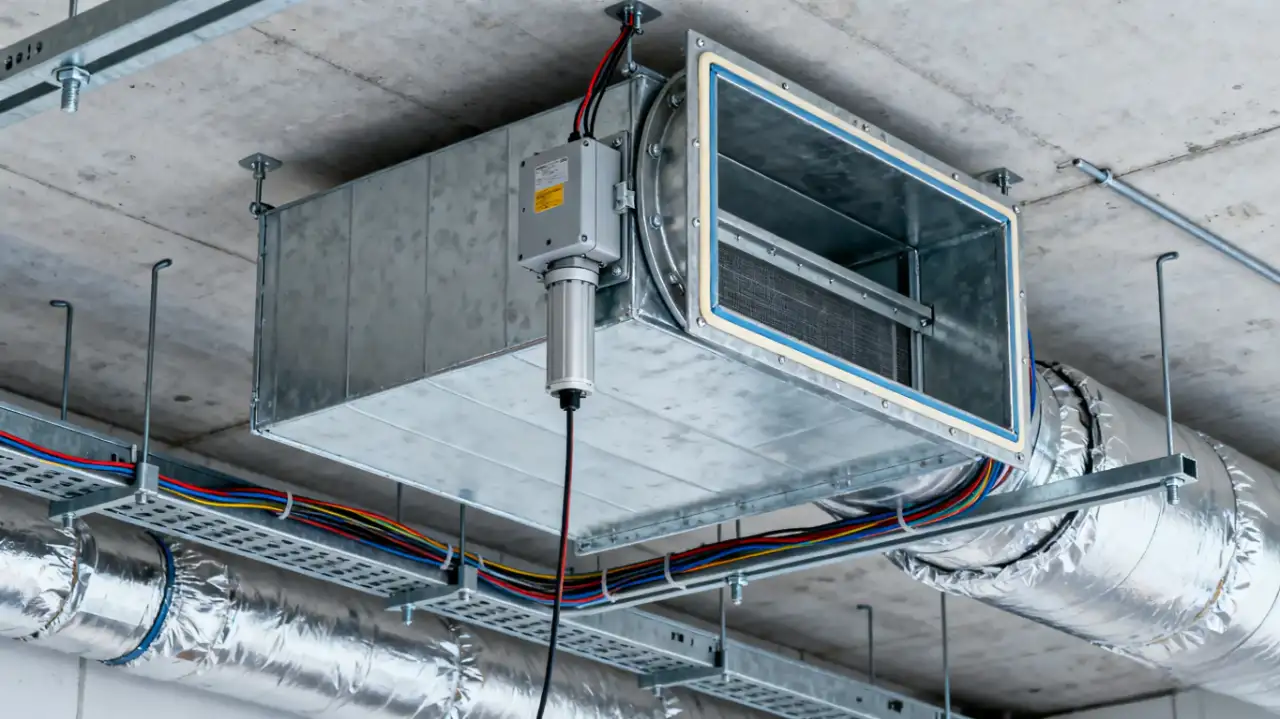 How Air Dampers Drive Efficiency in High Performance Buildings
How Air Dampers Drive Efficiency in High Performance Buildings -
 Why Semiconductor Manufacturing Can’t Function Without Cleanrooms
Why Semiconductor Manufacturing Can’t Function Without Cleanrooms -
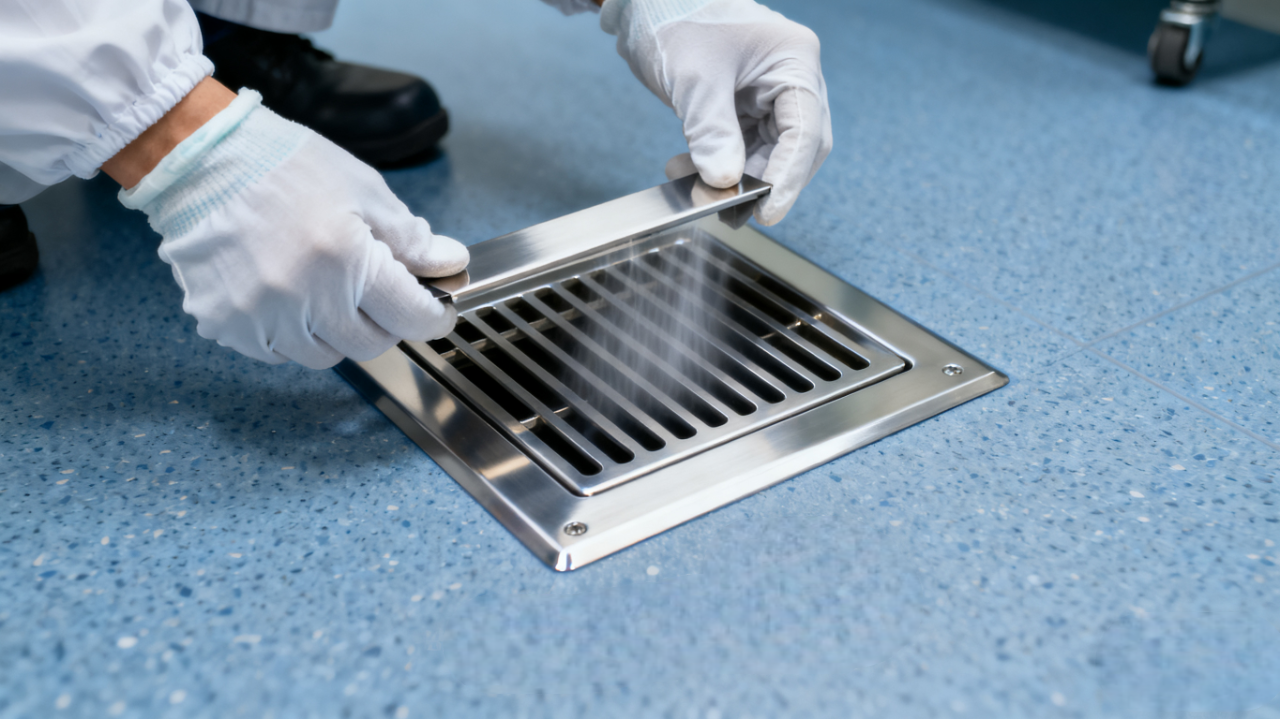 How to Select the Right Floor Vent for Cleanrooms
How to Select the Right Floor Vent for Cleanrooms -
 How to Clean and Maintain AC Registers for Peak HVAC Performance
How to Clean and Maintain AC Registers for Peak HVAC Performance

Guangzhou Yizhong Aluminum Industry Co., Ltd.
We are always providing our customers with reliable products and considerate services.
We are always providing our customers with reliable products and considerate services.


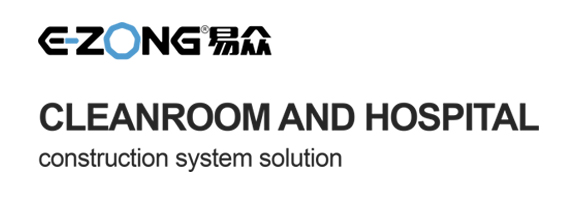
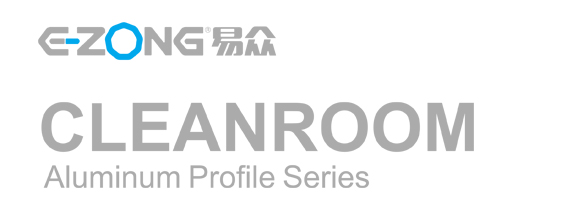






Speak Your Mind